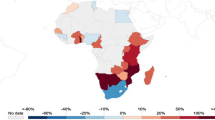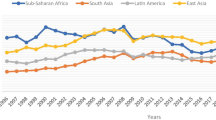Abstract
Malaysia is among the relatively more open economies in Asia. Many economic and environmental effects resulting from trade liberalization are cause of caution for more open economies like Malaysia. This study, by applying a computable general equilibrium, investigates the economic and environmental effects resulting from trade liberalization on Malaysia. It uses 2005 social accounting matrix as the main database in the model. By considering tariff reforms, this study concluded that 50 and 100 % trade liberalization, respectively, lead to 0.06 and 0.13 % increase in real gross domestic product and 0.6 and 1.29 % increase in trade flows. Therefore, greater liberalization leads to a greater increase in the overall real GDP and Malaysian trade flows. The 50 and 100 % tariff reforms also increase rural household consumption, respectively, by 0.45 and 0.92 % leading to an increase in their welfare by 0.49 and 1.01 %. There is such a situation for other household groups. Moreover, we found that both tariff reforms would lead to greater reduction in poverty gap and poverty severity (by 4.8 and 7.8 %, respectively) in urban households in comparison with other household groups. Results indicate that emissions of four more local air pollutants, (i.e., particular matter, CO, SO2 and NO x ) are predicted to decrease, respectively, by 12, 11, 11 and 12 % as a result of trade liberalization, while emission of carbon dioxide, as a global air pollutant, increases by 0.14 %. Results also suggest that the environmental impacts will be considerably greater, if the rate of tariff will be lower than the current rates.

Source: Department of environment

Soure: Author design

Source: Simulation results

Source: Simulation results

Source: Simulation results

Source: Simulation results
Similar content being viewed by others
Notes
Association of South East Asian Nations—(ASEAN).
Free Trade Agreement (FTA).
ASEAN Free Trade Agreement (AFTA).
They considered five air pollutants namely nitrogen oxides, sulfur dioxide, carbon monoxide, suspended particulate matter and carbon dioxide.
References
Aggarwal RM (2006) Globalization, local ecosystems, and the rural poor. World Dev 34(8):1405–1418
Alam S (2010) Globalization, poverty and environmental degradation: sustainable development in Pakistan. J Sustain Dev 3(3):103–114
Alarde-Regalado A, AFTA Research Team (2005) Regional report on the impact of trade liberalization on small scale producers in South East Asia: A cause for concern. Southeast Asian Council for Food Security and Fair Trade-SEACON. http://www.seacouncil.org/seacon/images/stories/publications/1033regional_report_on_trade_liberalization.pdf. Accessed 8 July 2016
Ali A (2009) Implications of trade liberalisation to Malaysia’s Mining Industry. Bull Geol Soc Malays 55:1–6. doi:10.7186/bgsm2009001
Atici C (2012) Carbon emissions, trade liberalization, and the Japan–ASEAN interaction: a group-wise examination. J Jpn Int Econ 26:167–178
Bajona C, Gibson MJ, Kehoe TJ, Ruhl KJ (2008) Trade liberalization, growth, and productivity. Federal Reserve Bank of Minneapolis, Minneapolis
Bandara JS (1999) Can trade liberalization have environmental benefits in developing country agriculture? A Sri Lankan case study. J Policy Model 21(3):349–374
Carneiro FG, Arbache JS (2003) The impacts of trade on the Brazilian labor market: a CGE model approach. World Dev 31(9):1581–1595
Chao CC, Yu ESH (2007) Trade liberalization, foreign ownership, and the environment in a small open economy. Int Rev Econ Finance 16:471–477
Chitiga M, Mabugu R, Kandiero T (2007) The impact of tariff removal on poverty in Zimbabwe: A computable general equilibrium microsimulation. J Dev Stud 43(6):1105–1125
Cole MA, Rayner AJ (2000) The Uruguay Round and air pollution: estimating the composition, scale and technique effects of trade liberalization. J Int Trade Econ Dev 9(3):339–354
Cororaton CB, Cockburn J (2007) Trade reform and poverty—Lessons from the Philippines: a CGE-microsimulation analysis. J Policy Model 29:141–163
Dessus S, Bussolo M (1998) Is there a trade-off between trade liberalization and pollution abatement? J Policy Model 20(1):11–31
Duy LN (2007) The impact of trade liberalization on the environment in some East Asian countries: an empirical study. http://www.cerdi.org/uploads/sfCmsContent/html/323/NguyenDuy.pdf
Fung KC, Maechler AM (2007) Trade liberalization and the environment: the case of intra-industry trade. J Int Trade Econ Dev 16(1):53–69
Ghani GM (2012) Does trade liberalization effect energy consumption? Energy Policy 43:285–290
Gumilang H, Mukhopadhyay K, Thomassin PJ (2011) Economic and environmental impacts of trade liberalization: the case of Indonesia. Econ Model 28:1030–1041
Ivanova A, Angeles M (2006) Trade and environment issues in APEC. Soc Sci J 43:629–642
Johansson RC, Cooper J, Peters M (2006) Analysis an agri-environmental assessment of trade liberalization. Ecol Econ 58:37–48
Kyophilavong P (2011) Trade liberalization, pollution and poverty: evidence from Lao PDR. Economy and Environment Program for Southeast Asia (EEPSEA), No. 2011-RR11
Murad M, Wahid M, Mohammad NH (2009) Trade and environment: review of relationship and implication of environmental Kuznets curve hypothesis for Malaysia. J Soc Sci 19(2):83–90
Oktaviani R, Haryadi EP (2008) Impacts of ASEAN agricultural trade liberalization on ASEAN-6 economies and income distribution in Indonesia. In: Asia-Pacific research and training network on trade, working papers, No 5108
Peng T, Cox TL (2006) An economic analysis of the impacts of trade liberalization on Asian dairy market. Food Policy 31:249–259
Peridy N (2006) Pollution effects of free trade areas: simulations from a general equilibrium model. Int Econ J 20(1):37–62
Raihan S (2010) Welfare and poverty impacts of trade liberalization: a dynamic CGE microsimulation analysis. Int J Microsimul 3(1):123–126
Salehezadeh Z, Rastegari SH (2002) The economic impacts of trade liberalization and factor mobility: the case of the Philippines. J Policy Model 24:483–486
Shaikh FM, Rahpoto MS (2009) Impact of trade liberalization and SAFTA on Pakistan’s economy by using CGE model. Int J Bus Manag 4(4):192–209
Shen J (2008) Trade liberalization and environmental degradation in China. Appl Econ 40(8):997–1004
Solaymani S (2015) Impacts of energy subsidy reform on poverty and income inequality in Malaysia. Qual Quant. doi:10.1007/s11135-015-0284-z
Solaymani S, Kari F (2013) Environmental and economic effects of high petroleum prices on transport sector. Energy 60(1):435–441. doi:10.1016/j.energy.2013.08.037
Solaymani S, Kari F, Hazli R (2014) Evaluating the role of subsidy reform in addressing poverty level in Malaysia: a CGE poverty framework. J Dev Stud 50:556–569
Solaymani S, Kardooni R, Kari F, Yusoff S (2015) Economic and environmental impacts of energy subsidy reform and oil price shock on the Malaysian transport sector. Travel Behav Soc 2:65–77. doi:10.1016/j.tbs.2014.09.001
Strutt A, Anderson K (2000) Will trade liberalization harm the environment? The case of Indonesia to 2020. Environ Resour Econ 17:203–232
Thirlwall AP (2000) Trade, trade liberalisation and economic growth: theory and evidence. In: The African Development Bank, Economic Research Papers, No. 63
Thomassin PJ, Mukhopadhyay K (2008) Impact of East-Asian free trade on regional greenhouse gas emissions. J Int Glob Econ Stud 1(2):57–83
Verburg R, Stehfest E, Woltjer G, Eickhout B (2009) The effect of agricultural trade liberalisation on land-use related greenhouse gas emissions. Glob Environ Change 19:434–446
Winters LA, Mcculloch N, Mckay A (2004) Trade liberalization and poverty: the evidence so far. J Econ Lit 42(1):72–115
Yang HY (2001a) Trade liberalization and pollution: a general equilibrium analysis of carbon dioxide emissions in Taiwan. Econ Model 18:435–454
Yang HY (2001b) Carbon emissions control and trade liberalization: coordinated approaches to Taiwan’s trade and tax policy. Energy Policy 29:725–734
Yeah KL, Yanagida JF, Yamauchi H (1994) Evaluation of external market effects and government intervention in Malaysia’s agricultural sector: a computable general equilibrium framework. Agric Econ 11(2–3):237–256
Author information
Authors and Affiliations
Corresponding author
Appendix
Rights and permissions
About this article
Cite this article
Solaymani, S., Shokrinia, M. Economic and environmental effects of trade liberalization in Malaysia. J. Soc. Econ. Dev. 18, 101–120 (2016). https://doi.org/10.1007/s40847-016-0023-x
Published:
Issue Date:
DOI: https://doi.org/10.1007/s40847-016-0023-x
Keywords
- Trade liberalization
- Environment
- CO2 emissions
- Computable general equilibrium (CGE)
- Tariff reform
- Poverty




